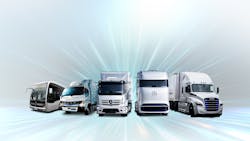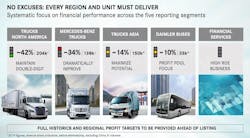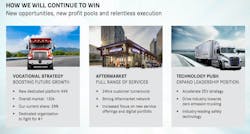Daimler Truck works to confront regional weaknesses
As Daimler Truck prepares for its independent future later this year, the company is focused on working out its financial weaknesses in certain regions while also going “all-in” on zero-emission truck development, explained Martin Daum, CEO of Daimler Truck AG, during a May 20 Strategy Day.
While Daimler Truck has a 40% market share in the North American heavy-duty segment, Daum explained that the company’s “inconsistent regional profitability records of Europe, Brazil, and Asia need to be improved significantly.”
“We are committed to confront our weaknesses,” Daum emphasized. “Chief amongst them is our failure to turn scale into enduring and financial success in all regions. With weakness in Europe, Asia, and Brazil, we have inconsistent regional profitability, and we must address this.”
In a recent move, Daimler Truck changed its organizational structure, and during the Strategy Day, Daum introduced the new Daimler Truck Board: Karin Rådström, CEO of Mercedes-Benz Trucks and responsible for the Europe and Latin America regions; John O'Leary, CEO of Daimler Trucks North America (DTNA); Hartmut Schick, CEO of Daimler Trucks Asia; and Andreas Gorbach, head of the Truck Technology Group.
“As we get ready for public life and as we get ready to raise performance, we needed a new approach,” Daum explained. “So, we have decided to give each region more independence and more entrepreneurial freedom to create a product and individual responsibility. And then we will focus each region on building a profit benchmark.”
“In North America, we are already the benchmark,” Daum added. “In other regions, we are far from it, and this needs to change. In Europe, the benchmark is double-digit margins; in Asia, it is high single-digit margins. And in Brazil, we have competitors that are profitable, and we are not.”Presenting the company's financial ambitions, Daimler Truck CFO Jochen Goetz said the company will aim for an overall double-digit return of sales by 2025. Daimler Truck will also intensify its focus on the most profitable segments and regions. This will include a clearer emphasis on the more profitable heavy-duty segment in the main regions and refocusing investments from internal combustion engine powertrains toward zero-emission and standardized global electric vehicle architectures, Goetz explained. Moving forward, Daum emphasized that Daimler Truck will pursue a dual strategy with both battery-electric and fuel-cell trucks.
Furthermore, Daimler Truck plans to grow its aftermarket and services revenues. This includes the traditional spare parts and maintenance service business, as well as financial services like tailor-made leasing, financing, and insurance. Company leaders also believe that new and fast-growing digitalized, autonomous and electrified transport services will add growth potential. Overall, Daimler Truck said it aims to increase the revenues on its service portfolio from the current 30% toward 50% in 2030.
Daimler Truck brands include Freightliner, Mercedes-Benz, Fuso, and BharatBenz.
DTNA’s new leader, market focus
At the end of April, DTNA’s former CEO Roger Nielsen officially retired after 35 years with the company. Nielsen’s successor O’Leary has resumed the leadership of DTNA after spending Q4 2020 and part of Q1 2021 in Germany launching the Mercedes-Benz Trucks transformation.
“I have a long history of serving in various leadership positions in North America,” O’Leary explained during the company’s Strategy Day. “This is a business I know intimately. My plan for the future is to expand both our market position and our profitability at Daimler Trucks North America.”
Although DTNA, which offers everything from electric school buses to the Class 8 Freightliner Cascadia, has 40% overall market share in North America, O’Leary pointed out that there remains “plenty of room for growth” in the small fleet and vocational segments.
Looking forward, DTNA will be focused on improved profitability, driven by cost control and increased revenue growth, O’Leary added. And that includes furthering technology leadership as part of the global Daimler Truck organization.
“Next, we will continue managing costs and leveraging our manufacturing footprint,” O’Leary said. “The truck business is cyclical, and we will account for fluctuations by remaining steadfast in our cost-control measures in both mixed overhead and variable costs.
“As the pandemic has taught us, our discipline, especially navigating recent supply chain disruptions, serves us well in good times and even more so in times of uncertainty,” he continued. “Moreover, we can maintain positive cash flow and profitability even down to a 165,000-unit market, which hasn’t happened in our professional lifetimes.”
Moving ahead, O’Leary explained that DTNA will focus on the vocational segment while leveraging the global technology toolkit of Daimler Truck. The mission comes off the heels of DTNA introducing its all-new Western Star 49X to the market.
“We have our sights set on achieving 45% of the vocational market, which means incrementally growing our share by 15% in a 130,000-unit market,” O’Leary explained. “While the 49X is arriving now, as the result of a $350 million investment we made four years ago, it’s just the beginning of a series of products aimed at this segment. Just as infrastructure spending is likely to increase in the U.S.”
Regarding DTNA’s aftermarket business, O’Leary said the company is committed to further advancing key performance indicators of getting trucks back on the road in 24 hours or less when repairs are required.
“The driver shortage is well documented, and it isn’t unusual for drivers to walk away from a broken-down truck after the second or third time it interferes with earning a living,” O’Leary pointed out. “Customers know and even accept that trucks break down in the severe-duty cycles to which they’re exposed. But what becomes critical and can put them at a competitive advantage is how quickly we can get that valuable driver and their valuable cargo back in operation again.”
In the Class 6-8 segments, DTNA’s Freightliner eCascadia and eM2 are slated to begin series production in late 2022.
“We already have 40 fully operational development units in customer hands, from which we obtain operational data, customer input, and afford our customers an opportunity to gain experience with the new technology,” O’Leary said.
He also said that DTNA will begin deliveries later this year for its battery-electric walk-in van chassis from Freightliner’s Custom Chassis division.
About the Author

Cristina Commendatore
Cristina Commendatore is a past FleetOwner editor-in-chief. She wrote for the publication from 2015 to 2023.


